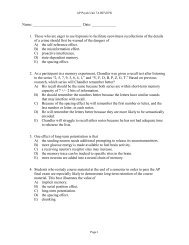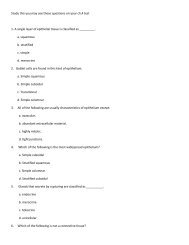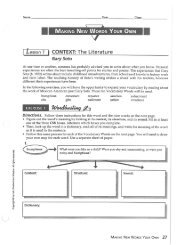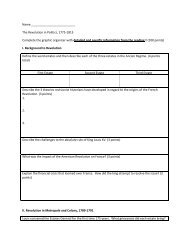8.5 Use Properties of Trapezoids and Kites
8.5 Use Properties of Trapezoids and Kites
8.5 Use Properties of Trapezoids and Kites
Create successful ePaper yourself
Turn your PDF publications into a flip-book with our unique Google optimized e-Paper software.
Your Notes<br />
<strong>8.5</strong> <strong>Use</strong> <strong>Properties</strong> <strong>of</strong> <strong>Trapezoids</strong><br />
<strong>and</strong> <strong>Kites</strong><br />
Goal p <strong>Use</strong> properties <strong>of</strong> trapezoids <strong>and</strong> kites.<br />
VOCABULARY<br />
Trapezoid<br />
Bases <strong>of</strong> a trapezoid<br />
Base angles <strong>of</strong> a trapezoid<br />
Legs <strong>of</strong> a trapezoid<br />
Isosceles trapezoid<br />
Midsegment <strong>of</strong> a trapezoid<br />
Kite<br />
Copyright © Holt McDougal. All rights reserved. Lesson <strong>8.5</strong> Geometry Notetaking Guide 221
Your Notes<br />
<strong>8.5</strong> <strong>Use</strong> <strong>Properties</strong> <strong>of</strong> <strong>Trapezoids</strong><br />
<strong>and</strong> <strong>Kites</strong><br />
Goal p <strong>Use</strong> properties <strong>of</strong> trapezoids <strong>and</strong> kites.<br />
VOCABULARY<br />
Trapezoid A trapezoid is a quadrilateral with exactly<br />
one pair <strong>of</strong> parallel sides.<br />
Bases <strong>of</strong> a trapezoid The parallel sides <strong>of</strong> a<br />
trapezoid are the bases.<br />
Base angles <strong>of</strong> a trapezoid A trapezoid has two pairs<br />
<strong>of</strong> base angles. Each pair shares a base as a side.<br />
Legs <strong>of</strong> a trapezoid The nonparallel sides <strong>of</strong> a<br />
trapezoid are the legs.<br />
Isosceles trapezoid An isosceles trapezoid is a<br />
trapezoid in which the legs are congruent.<br />
Midsegment <strong>of</strong> a trapezoid The midsegment <strong>of</strong><br />
a trapezoid is the segment that connects the<br />
midpoints <strong>of</strong> its legs.<br />
Kite A kite is a quadrilateral that has two pairs <strong>of</strong><br />
consecutive congruent sides, but opposite sides<br />
are not congruent.<br />
Copyright © Holt McDougal. All rights reserved. Lesson <strong>8.5</strong> Geometry Notetaking Guide 221
Your Notes<br />
Example 1 <strong>Use</strong> a coordinate plane<br />
Show that CDEF is a trapezoid.<br />
Solution<br />
Compare the slopes <strong>of</strong> opposite sides.<br />
Slope <strong>of</strong> }<br />
DE 5 5<br />
Slope <strong>of</strong> }<br />
CF 5 5 5<br />
1<br />
y<br />
D(1, 3) E(4, 4)<br />
C(0, 0)<br />
The slopes <strong>of</strong> }<br />
DE <strong>and</strong> }<br />
CF are the same, so }<br />
DE }<br />
CF .<br />
Slope <strong>of</strong> }<br />
EF 5 5 5<br />
Slope <strong>of</strong> }<br />
CD 5 5 5<br />
The slopes <strong>of</strong> }<br />
EF <strong>and</strong> }<br />
CD are not the same, so }<br />
EF is<br />
to }<br />
CD .<br />
Because quadrilateral CDEF has exactly one pair <strong>of</strong><br />
, it is a trapezoid.<br />
THEOREM 8.14<br />
If a trapezoid is isosceles, then each<br />
pair <strong>of</strong> base angles is .<br />
If trapezoid ABCD is isosceles, then<br />
∠A > ∠ <strong>and</strong> ∠ > ∠C.<br />
THEOREM 8.15<br />
If a trapezoid has a pair <strong>of</strong> congruent<br />
, then it is an isosceles<br />
trapezoid.<br />
If ∠A > ∠D (or if ∠B > ∠C), then trapezoid<br />
ABCD is isosceles.<br />
4<br />
B C<br />
F(6, 2)<br />
A D<br />
B C<br />
A D<br />
THEOREM 8.16<br />
A trapezoid is isosceles if <strong>and</strong> only<br />
B C<br />
if its diagonals are .<br />
Trapezoid ABCD is isosceles if <strong>and</strong> only if > .<br />
A D<br />
222 Lesson <strong>8.5</strong> Geometry Notetaking Guide Copyright © Holt McDougal. All rights reserved.<br />
x
Your Notes<br />
Example 1 <strong>Use</strong> a coordinate plane<br />
Show that CDEF is a trapezoid.<br />
y<br />
D(1, 3) E(4, 4)<br />
Solution<br />
Compare the slopes <strong>of</strong> opposite sides. 1<br />
Slope <strong>of</strong> C(0, 0) 4<br />
} 4 2 3 1<br />
DE 5 } 5 }<br />
4 2 1 3<br />
Slope <strong>of</strong> } 2 2 0 2<br />
CF 5 } 5 } 5<br />
6 2 0 6 1<br />
}<br />
3<br />
The slopes <strong>of</strong> }<br />
DE <strong>and</strong> }<br />
CF are the same, so }<br />
DE i }<br />
CF .<br />
Slope <strong>of</strong> } 2 2 4 22<br />
EF 5 } 5 } 5 21<br />
6 2 4 2<br />
Slope <strong>of</strong> }<br />
CD 5<br />
3 2 0<br />
}<br />
1 2 0<br />
5 3<br />
}<br />
1 5 3<br />
The slopes <strong>of</strong> }<br />
EF <strong>and</strong> }<br />
CD are not the same, so }<br />
EF is<br />
not parallel to }<br />
CD .<br />
Because quadrilateral CDEF has exactly one pair <strong>of</strong><br />
parallel sides , it is a trapezoid.<br />
THEOREM 8.14<br />
If a trapezoid is isosceles, then each<br />
pair <strong>of</strong> base angles is congruent .<br />
If trapezoid ABCD is isosceles, then<br />
∠A > ∠ D <strong>and</strong> ∠ B > ∠C.<br />
THEOREM 8.15<br />
If a trapezoid has a pair <strong>of</strong> congruent<br />
base angles , then it is an isosceles<br />
trapezoid.<br />
If ∠A > ∠D (or if ∠B > ∠C), then trapezoid<br />
ABCD is isosceles.<br />
B C<br />
F(6, 2)<br />
A D<br />
B C<br />
A D<br />
THEOREM 8.16<br />
A trapezoid is isosceles if <strong>and</strong> only<br />
B C<br />
if its diagonals are congruent . A D<br />
Trapezoid ABCD is isosceles if <strong>and</strong> only if }<br />
AC > }<br />
BD .<br />
222 Lesson <strong>8.5</strong> Geometry Notetaking Guide Copyright © Holt McDougal. All rights reserved.<br />
x
Your Notes<br />
Example 2 <strong>Use</strong> properties <strong>of</strong> isosceles trapezoids<br />
Kitchen A shelf fitting into a<br />
cupboard in the corner <strong>of</strong> a<br />
L<br />
kitchen is an isosceles trapezoid.<br />
Find m∠N, m∠L, <strong>and</strong> m∠M.<br />
508<br />
M<br />
K N<br />
Solution<br />
Step 1 Find m∠N. KLMN is an , so<br />
∠N <strong>and</strong> ∠ are congruent base angles, <strong>and</strong><br />
m∠N 5 m∠ 5 .<br />
Step 2 Find m∠L. Because ∠K <strong>and</strong> ∠L are consecutive<br />
interior angles formed by @##$ KL intersecting two<br />
parallel lines, they are . So,<br />
m∠L 5 2 5 .<br />
Step 3 Find m∠M. Because ∠M <strong>and</strong> ∠ are a pair<br />
<strong>of</strong> base angles, they are congruent, <strong>and</strong><br />
m∠M 5 m∠ 5 .<br />
So, m∠N 5 , m∠L 5 , <strong>and</strong> m∠M 5 .<br />
Checkpoint Complete the following exercises.<br />
1. In Example 1, suppose the coordinates <strong>of</strong> point E are<br />
(7, 5). What type <strong>of</strong> quadrilateral is CDEF? Explain.<br />
2. Find m∠C, m∠A, <strong>and</strong> m∠D A<br />
in the trapezoid shown.<br />
1358<br />
B C<br />
Copyright © Holt McDougal. All rights reserved. Lesson <strong>8.5</strong> Geometry Notetaking Guide 223<br />
D
Your Notes<br />
Example 2 <strong>Use</strong> properties <strong>of</strong> isosceles trapezoids<br />
Kitchen A shelf fitting into a<br />
cupboard in the corner <strong>of</strong> a<br />
L<br />
kitchen is an isosceles trapezoid.<br />
Find m∠N, m∠L, <strong>and</strong> m∠M.<br />
508<br />
M<br />
K N<br />
Solution<br />
Step 1 Find m∠N. KLMN is an isosceles trapezoid , so<br />
∠N <strong>and</strong> ∠ K are congruent base angles, <strong>and</strong><br />
m∠N 5 m∠ K 5 508 .<br />
Step 2 Find m∠L. Because ∠K <strong>and</strong> ∠L are consecutive<br />
interior angles formed by @##$ KL intersecting two<br />
parallel lines, they are supplementary . So,<br />
m∠L 5 1808 2 508 5 1308 .<br />
Step 3 Find m∠M. Because ∠M <strong>and</strong> ∠ L are a pair<br />
<strong>of</strong> base angles, they are congruent, <strong>and</strong><br />
m∠M 5 m∠ L 5 1308 .<br />
So, m∠N 5 508 , m∠L 5 1308 , <strong>and</strong> m∠M 5 1308 .<br />
Checkpoint Complete the following exercises.<br />
1. In Example 1, suppose the coordinates <strong>of</strong> point E are<br />
(7, 5). What type <strong>of</strong> quadrilateral is CDEF? Explain.<br />
Parallelogram; opposite pairs <strong>of</strong> sides are<br />
parallel.<br />
2. Find m∠C, m∠A, <strong>and</strong> m∠D A<br />
in the trapezoid shown.<br />
m∠C 5 1358, m∠A 5 458,<br />
m∠D 5 458<br />
1358<br />
B C<br />
Copyright © Holt McDougal. All rights reserved. Lesson <strong>8.5</strong> Geometry Notetaking Guide 223<br />
D
Your Notes<br />
THEOREM 8.17: MIDSEGMENT THEOREM FOR<br />
TRAPEZOIDS<br />
The midsegment <strong>of</strong> a trapezoid is A B<br />
parallel to each base <strong>and</strong> its length<br />
is one half the sum <strong>of</strong> the lengths<br />
M N<br />
<strong>of</strong> the bases.<br />
C<br />
If }<br />
MN is the midsegment <strong>of</strong> trapezoid ABCD, then<br />
}<br />
MN i , }<br />
MN i } , <strong>and</strong> MN 5 ( 1 ).<br />
In the diagram, }<br />
Example 3 <strong>Use</strong> the midsegment <strong>of</strong> a trapezoid<br />
<strong>of</strong> trapezoid PQRS. Find MN.<br />
Solution<br />
<strong>Use</strong> Theorem 8.17 to find MN.<br />
MN is the midsegment 16 in.<br />
P Q<br />
MN 5 ( 1 ) Apply Theorem 8.17.<br />
Checkpoint Complete the following exercise.<br />
3. Find MN in the trapezoid at P<br />
the right.<br />
30 ft<br />
S<br />
M<br />
N<br />
M<br />
Q<br />
12 ft<br />
R<br />
D<br />
S R<br />
9 in.<br />
5 ( 1 ) Substitute for PQ <strong>and</strong><br />
for SR.<br />
5 Simplify.<br />
The length MN is inches.<br />
224 Lesson <strong>8.5</strong> Geometry Notetaking Guide Copyright © Holt McDougal. All rights reserved.<br />
N
Your Notes<br />
THEOREM 8.17: MIDSEGMENT THEOREM FOR<br />
TRAPEZOIDS<br />
The midsegment <strong>of</strong> a trapezoid is A B<br />
parallel to each base <strong>and</strong> its length<br />
is one half the sum <strong>of</strong> the lengths<br />
M N<br />
<strong>of</strong> the bases.<br />
C<br />
If }<br />
MN is the midsegment <strong>of</strong> trapezoid ABCD, then<br />
}<br />
MN i }<br />
AB , }<br />
MN i }<br />
DC , <strong>and</strong> MN 5 1<br />
} ( AB 1 CD ).<br />
2<br />
In the diagram, }<br />
Example 3 <strong>Use</strong> the midsegment <strong>of</strong> a trapezoid<br />
<strong>of</strong> trapezoid PQRS. Find MN.<br />
Solution<br />
<strong>Use</strong> Theorem 8.17 to find MN.<br />
Checkpoint Complete the following exercise.<br />
3. Find MN in the trapezoid at P<br />
the right.<br />
MN 5 21 ft<br />
MN is the midsegment 16 in.<br />
P Q<br />
MN 5 1<br />
}<br />
2 ( PQ 1 SR ) Apply Theorem 8.17.<br />
30 ft<br />
S<br />
M<br />
N<br />
M<br />
Q<br />
12 ft<br />
R<br />
D<br />
S R<br />
9 in.<br />
5 1<br />
}<br />
2 ( 16 1 9 ) Substitute 16 for PQ <strong>and</strong><br />
9 for SR.<br />
5 12.5 Simplify.<br />
The length MN is 12.5 inches.<br />
224 Lesson <strong>8.5</strong> Geometry Notetaking Guide Copyright © Holt McDougal. All rights reserved.<br />
N
Your Notes<br />
Homework<br />
THEOREM 8.18<br />
If a quadrilateral is a kite, then its<br />
diagonals are . B<br />
If quadrilateral ABCD is a kite,<br />
then ⊥ .<br />
THEOREM 8.19<br />
If a quadrilateral is a kite, then<br />
exactly one pair <strong>of</strong> opposite angles<br />
are congruent.<br />
B<br />
If quadrilateral ABCD is a kite <strong>and</strong> }<br />
BC > }<br />
BA ,<br />
then ∠A ∠C <strong>and</strong> ∠B ∠D.<br />
Example 4 Apply Theorem 8.19<br />
Find m∠T in the kite shown at the right.<br />
Solution<br />
Copyright © Holt McDougal. All rights reserved. Lesson <strong>8.5</strong> Geometry Notetaking Guide 225<br />
C<br />
A<br />
C<br />
A<br />
Q 708<br />
By Theorem 8.19, QRST has exactly one<br />
pair <strong>of</strong> opposite angles.<br />
T<br />
888<br />
S<br />
Because ∠Q À ∠S, ∠ <strong>and</strong> ∠T must be<br />
congruent. So, m∠ 5 m∠T. Write <strong>and</strong> solve<br />
an equation to find m∠T.<br />
m∠T 1 m∠R 1 1 5 Corollary to<br />
Theorem 8.1<br />
m∠T 1 m∠T 1 1 5 Substitute m∠T<br />
for m∠R.<br />
(m∠T) 1 5 Combine like<br />
terms.<br />
m∠T 5 Solve for m∠T.<br />
Checkpoint Complete the following exercise.<br />
4. Find m∠G in the kite shown G H<br />
858<br />
at the right.<br />
J<br />
758<br />
I<br />
D<br />
D<br />
R
Your Notes<br />
Homework<br />
THEOREM 8.18<br />
If a quadrilateral is a kite, then its<br />
diagonals are perpendicular . B<br />
If quadrilateral ABCD is a kite,<br />
then }<br />
AC ⊥ }<br />
BD .<br />
THEOREM 8.19<br />
If a quadrilateral is a kite, then<br />
B<br />
exactly one pair <strong>of</strong> opposite angles<br />
are congruent.<br />
If quadrilateral ABCD is a kite <strong>and</strong> }<br />
BC > }<br />
BA ,<br />
then ∠A > ∠C <strong>and</strong> ∠B À ∠D.<br />
Example 4 Apply Theorem 8.19<br />
Find m∠T in the kite shown at the right.<br />
Solution<br />
Copyright © Holt McDougal. All rights reserved. Lesson <strong>8.5</strong> Geometry Notetaking Guide 225<br />
C<br />
A<br />
C<br />
A<br />
Q 708<br />
By Theorem 8.19, QRST has exactly one<br />
pair <strong>of</strong> congruent opposite angles.<br />
Because ∠Q À ∠S, ∠ R <strong>and</strong> ∠T must be<br />
T<br />
888<br />
S<br />
congruent. So, m∠ R 5 m∠T. Write <strong>and</strong> solve<br />
an equation to find m∠T.<br />
m∠T 1 m∠R 1 708 1 888 5 3608 Corollary to<br />
Theorem 8.1<br />
m∠T 1 m∠T 1 708 1 888 5 3608 Substitute m∠T<br />
for m∠R.<br />
2 (m∠T) 1 1588 5 3608 Combine like<br />
terms.<br />
m∠T 5 1018 Solve for m∠T.<br />
Checkpoint Complete the following exercise.<br />
4. Find m∠G in the kite shown<br />
at the right.<br />
m∠G 5 1008<br />
G<br />
858<br />
H<br />
J<br />
758<br />
I<br />
D<br />
D<br />
R








